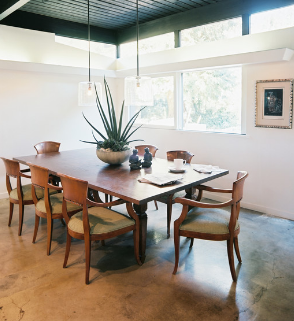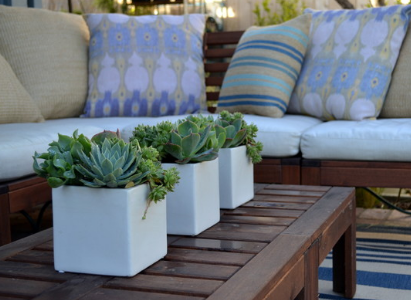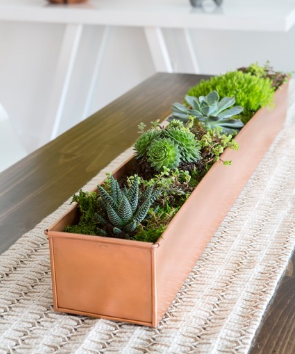

Why bother buying flowers when you can have a fresh focus that is just as beautiful and lasts for years? If you haven’t jumped on the succulent bandwagon, maybe we can convince you with these 10 amazing and diverse succulent centerpiece decorations.
Perfect for a display on an outdoor table or a decoration on a sunny windowsill, these miniature gardens are guaranteed to be a conversation starter at your next gathering. Best of all, they’re easier to assemble than they look and require little maintenance.

In the backyard of Santa Barbara, designed by interior designer Jessica Risko Smith, a low wooden trough is filled with succulents that grow along the center of the stand table. The design is simple yet timeless – perfect for a modern farmhouse-style dining table. To recreate this look, choose containers in neutral tones, preferably with narrow rectangular shapes, and choose a pastel gray-green palette for succulents, such as Pearlite Lotus (Echeveria spp., USDA Zones 9 to 11; Find your area) and silver-plated spider webs (Sempervivum arachnoideum, regions 4 to 9), both as shown. The plants seen here grow best in full to partial sunlight.

A vivid mix of red, orange, gold, and chartreuse succulents adds a splash of color to your garden. For outdoor displays, choose succulents that are exposed to sunlight for a darkening color, such as certain varieties of stone lotus flowers and hens and chicks (Sempervivum tectorum).
This bright mix of San Francisco Bay Area backyards designed by Shades Of Green Landscape Architecture includes orange ‘Sticks on Fire’ milk bushes (Euphorbia tirucalli ‘Sticks on Fire’, zones 10 to 11), lime green bracelets (Crassula muscosa, zones 9 to 11), orange-headed hens and chicks (Sempervivum). tectorum, zones 3 to 8) and the golden ‘Angelina’ sedum crop (Sedum rupestre ‘Angelina’, zones 3 to 11). All the succulents in the photo are thriving in full sun.

To really stand out, choose a focal plant with height and an interesting shape for your succulent center. Hillary Thomas Designs has planted potted snakes (saxifera) in this restaurant, with succulents underneath. Up close, one can admire the pale stone around the cast stone vessels and the base of the plant. When combining taller plants with succulents, make sure they have the same light and water requirements. The snake plant works well because it can tolerate very low moisture and variable light conditions.

In the Southern California backyard designed by Living Gardens Landscape Design, a triple repeating arrangement of succulents forms a laid-back and modern centerpiece. The plants planted include two species of stone lotus (Echeveria glauca and E. glauca). glauca var. pumila) as well as the “blue wave” of sedum.
Landscape architect Sacha McCrae offers a tip for recreating this lush look at home: “Fullness is key,” she says, “so we squeeze the plants in – no soil should be exposed when they’re done.” She also recommends limiting watering and placing centerpieces away from direct sunlight to help the tenderer succulents retain their pearly gray color. This special arrangement receives the morning sun.

Instead of using a ceramic container for this juicy centerpiece, Loftus Design’s designer Bridget Gasque used a giant faux clam shell to create a beach-like interior. She planted a variety of succulents, including the chestnut stone lotus and the greenish-white striped zebra plant (Haworthia fasciata, Zones 9 to 11), and filled the voids with well-preserved moss. While succulents require very little water, the preserved reindeer moss is sprayed with a layer of water every few days to maintain its soft texture. Succulents are best placed on a windowsill with bright indirect light.

Sometimes, the simplest centerpiece design may also be the most effective. In this backyard in Lichfield, Connecticut, a lineup of five multi-section containers, each with a green peony plant (Aeonium sp., Zone 9), forms a captivating tabletop display. The thick container and the repetitive shape of the succulents, both of which have a strong tactile feel, attract the eye.
To reproduce this effect, three or five sets of identical containers (perhaps varying heights) can be placed with a single variety of succulents, such as rosette-shaped peonies, cornflowers, or small tree-like jade trees (Crassula ovata, zones 10 to 12). Peonies (like the peony in the picture) grow best in filtered sunlight.

Use unusual planting containers to place your succulent centerpiece that can be easily separated or paired with a room. For example, at the surfer’s home in Los Angeles, succulents planted on metal pedestals look like an art de vivre against the cobalt blue walls.
The base and unusual arrangement echo the room’s other bohemian accessories, such as Southeast Asian-style wall sculptures and driftwood candelabras. Succulents need low water levels and bright indirect sunlight.

This succulent vignette on the terrace of Dallas is another example of the use of unusual planting containers. Here, the homeowner cut out the tops of several glass sangria and tequila bottles, leaving labels to add graphic interest, and filled the bottles with potting soil, pebbles, and mixed succulents, including blue chalk sticks (Senecio spp.). The overall effect is playful and eclectic.
Keep in mind that if the bottle doesn’t have a drain hole, you need to water it a little and move it indoors when it rains. These succulents will thrive in full sunlight.

This glass and metal globe almost completely encloses the mixed-grow succulents in a restaurant in Columbus, Ohio. The stunning centerpiece becomes the focal point of the room, beckoning people to take a closer look.
Although the bottom layer of most terrarium is filled with sand and charcoal to help absorb excess moisture, you need to be extra careful not to overwater it to keep the succulents happy in this environment.

To make low-water succulents look more lush, try combining them with moss – whether it’s a flower-preserving variety or a live plant. In this copper trough designed by Décor Aid, moss fills the void between the stone lotus, the zebra plant and the hen and chick.
Most live mosses require more water than succulents, but additional water can be given by spraying water every few days without overwatering succulents. To achieve the same look without the extra hassle, choose well-preserved moss – vaping is an added benefit, not a necessity.
1. Locate the container. Choose a container that is relatively shallow and has the right table size. This can be a low plant container in a nursery, a converted ceramic bowl or a funky recycling container like a large seashell, an antique metal tray or a jar collection. For outdoor containers, make sure there are drainage holes, as succulents can rot in moist soil. For indoor containers, choose one that doesn’t have drainage holes, but be sure not to overwater it.
2. Choose your succulents. Depending on the look you want for the centerpiece, choose a mix of small succulents of various shapes, sizes, and colors to grow together, or choose one or two separate specimens, each occupying its own container. In general, it’s best to add one or two low-growth fillers (such as hens and chicks) and creeping varieties (such as sedum crops) to cover bare soil.
Also consider where you want to place your succulent centerpiece. For outdoor displays, choose succulents that thrive in the sun. For indoor containers, use succulents that can grow in lower light, such as certain types of aeium and mistletoe cacti (Rhipsalis baccifera).
3. Start planting. Use a quick-draining potting mix and plant succulents and cacti shallowly, making sure the soil doesn’t cover their canopy or fleshy leaves. For mixed planting, start with the largest succulent as an anchor point, then plant smaller varieties around its base, leaving space at the edge of the container to tuck in creeping varieties (such as Sedum “Angelina”).
4. Add finishing touches. Cover the soil with top dressing materials such as gravel, sea glass, fine bark mulch, or preserved moss, or fill gaps with low-growth succulents to cover the soil naturally. Top dressing not only gives the container a perfect appearance, but also reduces the need for water.
5. Take care of your plants. Most succulents grow best in bright, indirect sunlight for four to six hours a day. You may need to move indoor containers outside regularly to give them some sunlight, or choose succulents that can tolerate less light for indoor use. Keep in mind that some succulents, especially those that are Xi growing indoors, can get burned if exposed to hot, baking sun.
Water the base of the plant once a week and avoid spraying from the top of your head. Allow the top 1 to 2 inches of soil to dry before watering.